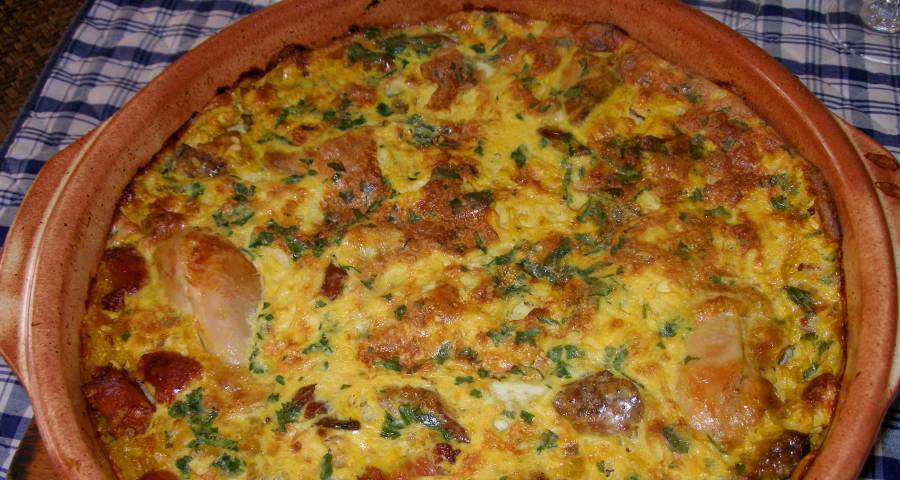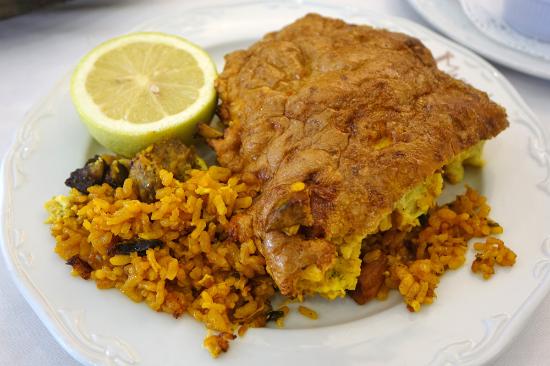Arroz con Costra is yet another great Spanish rice dish that is relatively simple to make and tastes delicious. Claimed to be from the Southern-Alicante/Murcia region of Spain, this rice dish is a perfect example of how different cooking techniques are blended between regions.

Alicante is one of Spain's best regions for rice dishes, after Valencia where the ever-famous paella originated. However this dish is an unusual blend between a casserole and a paella, and when including an egg crust, it makes for a very unique but traditional dish.
The name of the dish, 'Arroz con costra' derives from this 'egg topping' - 'costra' means ‘crust’ in Spanish when used with food. This is because when the egg is baked on the top of the rice casserole, it turns into a tasty crust that compliments the meal exquisitely.
In this recipe, it is customary to include a typical Spanish sausage called 'butifarra blanca'. This is a white sausage and is typical of Murcia and the Valencian Community. The sausage is white as it is only made from pork meat. However, if you can't find Butifarra blanca you can replace it with a similar white sausage.
Similarly, chicken is used in this recipe but many traditional versions of the dish use rabbit so you can choose whichever you prefer.
The largest dish of Crusty rice ever to be cooked ever was made using 1,500 eggs, 100 kilograms of rice and 120 kilograms of rabbit. The dish, which provided 1,500 servings, made it into the Guinness Book of World Records, helping immortalise the dish forever.

This is what you will need for 6 servings - Crusty Rice with Spare Ribs and Chicken
Ingredients:
• ½ cup Olive oil
• ½ lb spare ribs, chopped
• 2 butifarras blancas, cut into 2cm thick slices (optional)
• ½ lb pork loin, cut into large cubes
• 6 chicken legs
• 1½ tsps salt
• 2 tomatoes, peeled and chopped
• 4 cups chicken stock
• 1 tsp sweet paprika
• 2 cups Spanish round rice
• 6 eggs, beaten
Preparation:
• Preheat the oven to 230ºC (450ºF).
• Heat the olive oil over a medium-high heat in a large (around 30 centimetres in diameter), deep casserole dish. Add the spareribs, sausage slices, pork and chicken and cook, turning as necessary, for around 10 minutes or until the meat is nicely golden brown all over, turning to a slight crisp.
• Add the salt and the tomatoes to the pan and mix well.
• In a saucepan, bring the chicken stock to the boil and then turn down the heat, but keep it at a slight simmer. It needs to be hot when you add it to the rest of the dish.
• Add the paprika to the casserole dish containing the meat and tomato mixture and mix briskly to mix the flavour in. Then add the stock to the mixture and turn up the heat to high, bringing it all to the boil quickly
• Add the rice and stir the mixture to blend it with the rest of the ingredients, and make sure that it is evenly distributed throughout.
• Turn the heat down to medium-low and cook for 3 minutes without stirring.
• Next, place the casserole dish in the oven and bake it for 10 minutes or until the rice has become soft and absorbed most of the stock. Pour the beaten eggs evenly over the surface of the rice and bake for a further 5 minutes or until the eggs forms a crust on the top of the dish.
• Remove from the oven and serve immediately.
Enjoy!
